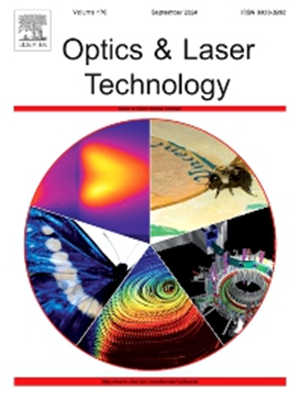Chirped fiber Bragg gratings directly inscribed by a femtosecond laser in an ytterbium-doped fiber for spectrum recovery, loss compensation and effective use in a CPA scheme
IF 4.6
2区 物理与天体物理
Q1 OPTICS
引用次数: 0
Abstract
Point-by-point femtosecond laser inscribed chirped Bragg gratings are good candidates for use in fiber chirped pulse amplification systems due to the high flexibility of their dispersion properties, low cost, and no length limitation. However, such gratings have two significant drawbacks: high losses and distortions of the short-wavelength part of the spectrum when operating in the normal group velocity dispersion mode. We propose a novel approach based on writing such gratings in a highly doped active fiber, which allows us to correct both shortcomings. We have also demonstrated, for the first time to our knowledge, a successful use of such gratings as stretchers in a fiber chirped pulse amplification system.
在掺镱光纤中使用飞秒激光直接刻划啁啾光纤布拉格光栅,以恢复频谱、补偿损耗并在 CPA 方案中有效使用
逐点飞秒激光刻划的啁啾布拉格光栅因其色散特性的高度灵活性、低成本和无长度限制而成为光纤啁啾脉冲放大系统的理想选择。然而,这种光栅有两个明显的缺点:在正常群速度色散模式下工作时,损耗大,光谱的短波长部分失真。我们提出了一种基于在高掺杂有源光纤中写入此类光栅的新方法,从而纠正了这两个缺点。据我们所知,我们还首次成功地在光纤啁啾脉冲放大系统中使用这种光栅作为拉伸器。
本文章由计算机程序翻译,如有差异,请以英文原文为准。
求助全文
约1分钟内获得全文
求助全文
来源期刊
CiteScore
8.50
自引率
10.00%
发文量
1060
审稿时长
3.4 months
期刊介绍:
Optics & Laser Technology aims to provide a vehicle for the publication of a broad range of high quality research and review papers in those fields of scientific and engineering research appertaining to the development and application of the technology of optics and lasers. Papers describing original work in these areas are submitted to rigorous refereeing prior to acceptance for publication.
The scope of Optics & Laser Technology encompasses, but is not restricted to, the following areas:
•development in all types of lasers
•developments in optoelectronic devices and photonics
•developments in new photonics and optical concepts
•developments in conventional optics, optical instruments and components
•techniques of optical metrology, including interferometry and optical fibre sensors
•LIDAR and other non-contact optical measurement techniques, including optical methods in heat and fluid flow
•applications of lasers to materials processing, optical NDT display (including holography) and optical communication
•research and development in the field of laser safety including studies of hazards resulting from the applications of lasers (laser safety, hazards of laser fume)
•developments in optical computing and optical information processing
•developments in new optical materials
•developments in new optical characterization methods and techniques
•developments in quantum optics
•developments in light assisted micro and nanofabrication methods and techniques
•developments in nanophotonics and biophotonics
•developments in imaging processing and systems

 求助内容:
求助内容: 应助结果提醒方式:
应助结果提醒方式:


